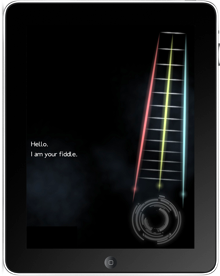
Music media company Smule just completed a soft release of its new application on iTunes earlier this month. The new “app” for the iPad, dubbed the Magic Fiddle, claims it will teach nonmusicians the quick ’n’ dirty basics of how to play the instrument. The product description states: “Your untrained fingers will play beautiful music in a matter of minutes.” The company’s Web site even features a YouTube video of the St. Lawrence String Quartet playing Johann Pachelbel’s Canon in D Major. But is it true? Is a touch-screen app really comparable to the real thing?
The visceral response from the music community, or from anyone who knows someone from that music community, is “no.” The Magic Fiddle has some obvious problems. The first is, perhaps, most glaring: Most string instruments, with the exception of the guitar family (sans Jaco Pastorius’ fretless wonder), lack a fret board. The second is the number of strings.
“Violinists are disappointed about the lack of the G string [Magic Fiddle has only three strings: D, A, and E], and the fact [that] we currently don’t support open strings or harmonics,” says Jeff Smith, CEO and cofounder of Smule.
“We have incredible respect and reverence for those who have mastered the art of pulling horse hair across sheep gut to make beautiful sounds,” says Smith. “Magic Fiddle is perhaps for everyone else.”
Featured Video
The St. Lawrence String Quartet demonstrates the Magic Fiddle iPad application.
Related Article
“Clifft Notes”: Portable Music Theory for the iPhone Age
October 19, 2010
Magic Fiddle can be likened in functionality to a Guitar Hero or Rock Band instrument and even offers a story book that explains techniques such as vibrato and glissandos. And, as with anything, a little practice can yield recognizable, albeit simplistic, music. It is a rare experience, even a treat, for the nonmusician. But remember, Magic Fiddle is an application. It was created for fun.
Classical Voice asked musician Catherine Sparacino to try out the app; both she and her son gave it a workout. Sparacino writes:
Both my 13-year-old son and I have played with the app a few times. He thought it was a great idea but found it uncomfortable to play. He found the instructions a little frustrating. He did like the sound a lot, and loved the choice of music.I agree with that. The sound is wonderful — beautiful actually. I found the bowing to be my favorite part although I certainly need a lot more practice! I think the thing I had the most trouble with was the positioning of the iPad for playing. I know it is how one would hold a fiddle but for me the iPad is just too short and I had trouble getting comfortable with it. I also had problems because of my glasses. They are bifocals and I had some trouble seeing the lines going to the strings coming in from the left. I found the instructions from those lines a little confusing at first but they made more sense to me as I played with the app more. I think I will enjoy it more as I continue to play with it.
Despite its usage, the Fiddle’s sound and similarity to real instruments is jarringly close enough to evoke outrage, wonder, and even intrigue.
“Technology is great but it is still quite limited in its ability to mimic real life in real time,” a local DJ comments. “It is continually getting closer, and in certain contexts like recording, it can make life easier and more efficient. But it still has a long way to go to match all the nuances of the human experience.”
Fortunately, human imitation isn’t the goal. Creators of the app want to make music available to as many people as possible. Mastering an instrument requires an investment of time and money, and takes years of practice, which limits the number of people who can participate. But Magic Fiddle is not about mastery; it’s about accessibility. Those without the skill can borrow the coveted sounds for a short time. Although no one quite knows what to make of the Fiddle, the music industry has been invited to join in the effort to share music with others.
“I don’t think they [recording engineers] know what to think about it yet, which is similar to our own perspective,” says Smith. “We would love to collaborate with the music industry to make more published content available for users to learn to play.”
Just as digital technology allowed for the resurgence of home recording studios and gave the average Jane and Joe access to the Internet, by merely owning a cell phone, music aficionados needn’t be afraid of Magic Fiddle. It won’t replace real instruments or the human touch that enlivens them.
“If we could have one more person trying to learn the Allegretto from Beethoven’s Seventh [Symphony], we would consider that a victory,” says Smith. “[We want people] to discover the joy of creating and sharing music with others. Music is meant to be social.”
